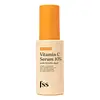What's inside
What's inside
 Key Ingredients
Key Ingredients

 Benefits
Benefits

 Concerns
Concerns

No concerns
 Ingredients Side-by-side
Ingredients Side-by-side

Water
Skin Conditioning3-O-Ethyl Ascorbic Acid
Skin ConditioningDimethyl Isosorbide
SolventButylene Glycol
HumectantEthoxydiglycol
HumectantSodium Citrate
BufferingCitric Acid
Buffering1,2-Hexanediol
Skin ConditioningSodium Gluconate
Skin ConditioningFerulic Acid
AntimicrobialCoceth-7
EmulsifyingPhenoxyethanol
PreservativePPG-1-PEG-9 Lauryl Glycol Ether
EmulsifyingFullerenes
AntimicrobialTocopheryl Acetate
AntioxidantEthylhexylglycerin
Skin ConditioningPEG-40 Hydrogenated Castor Oil
EmulsifyingPvp
Emulsion StabilisingTrisodium Ethylenediamine Disuccinate
Water, 3-O-Ethyl Ascorbic Acid, Dimethyl Isosorbide, Butylene Glycol, Ethoxydiglycol, Sodium Citrate, Citric Acid, 1,2-Hexanediol, Sodium Gluconate, Ferulic Acid, Coceth-7, Phenoxyethanol, PPG-1-PEG-9 Lauryl Glycol Ether, Fullerenes, Tocopheryl Acetate, Ethylhexylglycerin, PEG-40 Hydrogenated Castor Oil, Pvp, Trisodium Ethylenediamine Disuccinate
Water
Skin Conditioning3-O-Ethyl Ascorbic Acid
Skin ConditioningEthoxydiglycol
HumectantButylene Glycol
HumectantPanthenol
Skin ConditioningTriethanolamine
BufferingFerulic Acid
AntimicrobialAllantoin
Skin ConditioningPhenoxyethanol
PreservativePentylene Glycol
Skin ConditioningSodium Hyaluronate
HumectantGlycerin
HumectantTocopheryl Acetate
AntioxidantLactobacillus/Lemon Peel Ferment Extract
Skin ConditioningCitrus Aurantium Dulcis Peel Extract
Emulsion StabilisingAcrylates/C10-30 Alkyl Acrylate Crosspolymer
Emulsion StabilisingTranexamic Acid
AstringentTranexamoyl Dipeptide-22
BleachingNicotinoyl Dipeptide-22
Skin ConditioningBifida Ferment Lysate
Skin ConditioningEthylhexylglycerin
Skin ConditioningSodium Bisulfite
AntioxidantWater, 3-O-Ethyl Ascorbic Acid, Ethoxydiglycol, Butylene Glycol, Panthenol, Triethanolamine, Ferulic Acid, Allantoin, Phenoxyethanol, Pentylene Glycol, Sodium Hyaluronate, Glycerin, Tocopheryl Acetate, Lactobacillus/Lemon Peel Ferment Extract, Citrus Aurantium Dulcis Peel Extract, Acrylates/C10-30 Alkyl Acrylate Crosspolymer, Tranexamic Acid, Tranexamoyl Dipeptide-22, Nicotinoyl Dipeptide-22, Bifida Ferment Lysate, Ethylhexylglycerin, Sodium Bisulfite
 Reviews
Reviews

Ingredients Explained
These ingredients are found in both products.
Ingredients higher up in an ingredient list are typically present in a larger amount.
You might know this ingredient as Ethyl Ascorbic Acid, a more stable version of ascorbic acid.
Like other types of vitamin C, this ingredient has many benefits including reducing wrinkles, skin soothing, dark spot fading, and fighting against free radicals.
3-O-Ethyl Ascorbic Acid interferes with the process of skin darkening, helping to reduce hyperpigmentation. It also encourages the skin to produce more collagen.
Once applied, 3-O-Ethyl Ascorbic Acid is converted to Vitamin C deeper in the skin's layers. This process is slow but makes this ingredient more tolerable for skin.
The optimum pH range for this ingredient is 4 - 5.5
Learn more about 3-O-Ethyl Ascorbic AcidButylene Glycol (or BG) is used within cosmetic products for a few different reasons:
Overall, Butylene Glycol is a safe and well-rounded ingredient that works well with other ingredients.
Though this ingredient works well with most skin types, some people with sensitive skin may experience a reaction such as allergic rashes, closed comedones, or itchiness.
Learn more about Butylene GlycolEthoxydiglycol is a synthetic solvent.
Solvents are used to keep ingredients together in a product. They can help dissolve ingredients to stable bases or help evenly distribute ingredients throughout the product.
Ethoxydiglycol also helps deliver other key ingredients into the skin.
Learn more about EthoxydiglycolEthylhexylglycerin (we can't pronounce this either) is commonly used as a preservative and skin softener. It is derived from glyceryl.
You might see Ethylhexylglycerin often paired with other preservatives such as phenoxyethanol. Ethylhexylglycerin has been found to increase the effectiveness of these other preservatives.
Ferulic Acid is a plant based antioxidant. By fighting free-radicals, ferulic acid can help reduce the formation of fine lines and hyperpigmentation.
When used with Vitamin C, Ferulic Acid has shown to prevent Vitamin C from breaking down. In other words, it acts as a stabilizer.
Ferulic Acid is sometimes used to preserve food. Foods containing Ferulic Acid include: oats, rice, eggplant, citrus.
In medicine, Ferulic Acid is being studied for helping with diabetes, Alzheimer's, and cardiovascular diseases.
Learn more about Ferulic AcidPhenoxyethanol is a preservative that has germicide, antimicrobial, and aromatic properties. Studies show that phenoxyethanol can prevent microbial growth. By itself, it has a scent that is similar to that of a rose.
It's often used in formulations along with Caprylyl Glycol to preserve the shelf life of products.
Tocopheryl Acetate is AKA Vitamin E. It is an antioxidant and protects your skin from free radicals. Free radicals damage the skin by breaking down collagen.
One study found using Tocopheryl Acetate with Vitamin C decreased the number of sunburned cells.
Tocopheryl Acetate is commonly found in both skincare and dietary supplements.
Learn more about Tocopheryl AcetateWater. It's the most common cosmetic ingredient of all. You'll usually see it at the top of ingredient lists, meaning that it makes up the largest part of the product.
So why is it so popular? Water most often acts as a solvent - this means that it helps dissolve other ingredients into the formulation.
You'll also recognize water as that liquid we all need to stay alive. If you see this, drink a glass of water. Stay hydrated!
Learn more about Water